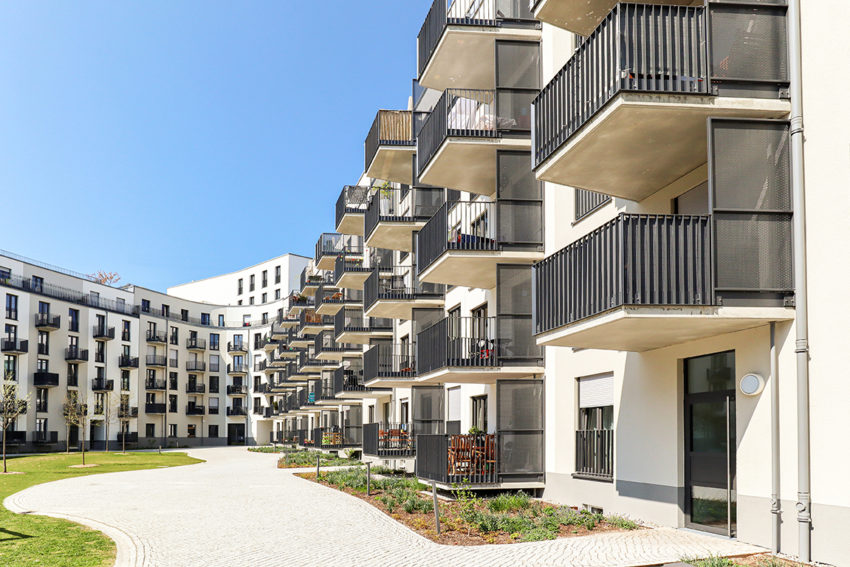Despite the uncertainty of the COVID-19 pandemic, there hasn’t been a migration away from multifamily living as many thought there would be. The multifamily market remained steady and lean with activity followed by a slight dip mid-year. The multifamily market continues to be highly competitive with an uptick in major mergers and acquisitions. In this article, we’ll explore the following topics to understand this multifamily market activity:
- The competitive market for multifamily properties
- Drivers and implications of increased market activity
- Key concepts to consider in the acquisition processes
The competitive market for multifamily firms
The coming year looks promising; in the CBRE 2021 US Real Estate Outlook1, multifamily sector investment volume was projected to rise 33% to $148 billion. Multifamily Executive2 quotes the CBRE report to explain this multifamily activity: “The economic rebound will lead to rising multifamily demand, largely from ‘unbundling’—certain renters moving out of their parents’ homes or those of friends as job opportunities provide more financial flexibility to live independently.” Multifamily Executive goes on to say, “In addition, COVID-related factors, as well as high housing costs and shifting demographics, have currently impacted the appeal of urban submarkets. Suburban multifamily communities are expected to outpace urban properties in the recovery.” There’s no doubt that multifamily activity continues to rise with major mergers and acquisitions to support this. The founder of Newmark Dallas3 recently said there currently is more buyer demand than there is product for DFW’s multifamily market.

Additional activity:
- Owner and operator Morgan Properties partnered with Olayan America to acquire a portfolio of 48 apartment communities with 14,414 units in 11 states for $1.75 billion.4
- Multifamily leaders Texas-based RPM and Atlanta-based CF Real Estate services are merging to create a national footprint with more than 84,000 units in 17 states.5
- Utah’s multifamily market hit sales volume levels of $1.63 billion in 2020.6
- Jordan Fisher, Principal, Next Wave Investors noted his acquisitions in the Phoenix market in Multi-Housing News7, “We recently capitalized on high investor demand with the sale of La Estrella Vista, a 96-unit multifamily community in the Far West submarket of Phoenix.”
Drivers and implications of increased market activity
With a surge of increased activity in the multifamily market, there are plenty of theories as to why this is happening including high residential market demand and lifestyle preferences, a continuation of the pre-pandemic market trend, and shifting investor preferences. The National Apartment Association8 reported that the U.S. needs about 4.6 million new multifamily units by 2030 to keep up with demand. That’s about 328,000 new units annually over the next 10 years. Driving factors seem to stem from the “renters-by-choice” lifestyle of millennials. With rising costs of homeownership, student debt, and overall lifestyle preferences, renting is seen to be far more attractive to the millennial generation than owning. According to HousingWire9, recent surveys show that 32% of rental households don’t believe the American Dream includes homeownership, 26% of people who do own a home wish they were renting instead, and 20% say they never plan on buying a home in their lifetime.

Investors who usually purchase non-multifamily properties are now turning to multifamily due to its resilience in the market. Since 2018, investor preferences have shifted, supporting this notion. According to NEWMARK10, “The change in allocations [towards Multifamily assets] is being driven by several factors, including a shift toward institutional ownership; stronger risk-adjusted returns in the favored sectors; and growth opportunities in…rental housing….While high levels of NOI growth also are responsible for multifamily returns, employment and population growth in secondary markets—particularly in the Sunbelt—have helped support high total returns.”
With all this multifamily property market activity, it’s important to ensure that assessments and due diligence are as comprehensive and streamlined as possible. A Forbes article11 on multifamily real estate investment says, “The stabilizing economy may offer opportunities for investment growth; however, poorly managed income properties flounder in any economic climate. Consequently, multifamily investors should take precautions to ensure lean operations and tenant appeal to stay competitive and profitable.” The Forbes article offers guidance for acquisition viability, “Exercise thorough due diligence on the market and subject property….Focus on efficiency in energy, labor, and material utilization. Do this by implementing sustainable design strategies in renovations and new builds, and leveraging SaaS technology to streamline asset and property management functions.”
Key concepts to consider in the acquisition process
- Include energy efficiency, resident expectations, aesthetics, and construction efficiency early in the process. When deals need to close quickly, the due diligence process must be efficient, but that doesn’t mean energy efficiency should be skipped until later. An energy evaluation will identify opportunities to reduce operating costs, improve resident experiences and aesthetics, and facilitate construction efficiency to help meet the overall financial goals of the investment. Including an energy efficiency evaluation as part of the due diligence process should be common practice for all acquisitions, not just when required for green loans. Pre-acquisition is the ideal time to include an energy audit to maximize your investment. The commercial sector has the Standard Guide for Building Energy Performance and Improvement Evaluation in the Assessment of Property Condition (ASTM E3224-1912). A streamlined energy evaluation process should also be used when assessing multifamily properties.
- Avoid costly energy efficiency plan delays and prove increased cash flow. Waiting to evaluate energy efficiency can mean running inefficient appliances and lighting, which increases operational costs unnecessarily. A developed energy efficiency plan improves net operating income as quickly as possible. Prioritizing “low-hanging fruit” opportunities such as inefficient appliances, water-saving features, improved HVAC and lighting, etc. can impact operating costs right away. The earlier these opportunities are implemented during the hold period, the more time (and data) you’ll have to prove the increased cashflow and property value increase.
- Set realistic budget expectations and be ready to execute rapidly on findings post-acquisition. By evaluating energy efficiency before the acquisition, property managers can develop their post-acquisition plans right away and be ready to execute as early as possible. Preparation will be a strong contributing factor to the success of your due diligence process through combating long lead times, reviewing budgets, and allocating funds as needed to taking action on findings. With strong preparation, being ready to combat common roadblocks leads to seamless, rapid execution.

Experienced energy efficiency auditors in the multifamily space have guidelines to follow and can quickly perform an evaluation at the same time as other auditors, without impacting the due diligence timeline. Working with an experienced energy efficiency partner is a proven, effective method for implementing results-oriented energy efficiency plans. An experienced energy efficiency partner saves time and money that most professionals can’t afford to lose, especially during the acquisition process. In addition to time and cost savings, working with a professional ensures all auditing requirements are met and accounted for. That’s why several of the top 50 NMHC leaders that are acquiring multifamily properties have partnered with the multifamily acquisition experts at SitelogIQ to help overcome obstacles and develop successful national energy efficiency rollouts.
For more information about including energy efficiency in the due diligence process, call us at 855 581 6464, or email CI_Multifamily@sitelogiq.com.
Subscribe for Updates from SitelogIQ!
https://app-3qnob2f5g6.marketingautomation.services/prospector/form/MzawMLEwNTQyBQA/MzFLSzQzMjHQTbWwSNU1MbQ00U00STXUNUgxNrSwNDU2TDJJAQA?rf__sb=https%3A%2F%2Fwww.sitelogiq.com%2Fblog%2F&_tk=202101|601418f79e564e1a5747d494&instance=v3du
SOURCES
1 CRBE. “CBRE’s 2021 US Real Estate Outlook: Speed of Recovery Mixed, with Quicker Rebound for Industrial, Multifamily and Data Centers” (November 12,2020) Accessed at https://www.cbre.us/about/media-center/2021-us-real-estate-outlook
2 Serlin, C. “CBRE Outlook: Quicker Rebound Expected for Multifamily in 2021” (November 17, 2020) Accessed at https://www.multifamilyexecutive.com/property-management/apartment-trends/cbre-outlook-quicker-rebound-expected-for-multifamily-in-2021_o
3 O’Boyle, B. “DFW’s Multifamily Market Continues to Surge” (March 30, 2021) Accessed at https://www.dmagazine.com/commercial-real-estate/2021/03/dfws-multifamily-market-continues-to-surge/?ref=feat-sect
4 Serlin, C. “Morgan Properties and Olayan America Purchase Massive Multifamily Portfolio” (February 24, 2021) Accessed at https://www.multifamilyexecutive.com/business-finance/morgan-properties-and-olayan-america-purchase-massive-multifamily-portfolio_o
5 Serlin, C. “RPM and CF Real Estate Services Merge” (March 8, 2021) Accessed at https://www.multifamilyexecutive.com/property-management/rpm-and-cf-real-estate-services-merge_o
6 Utah Business. “Utah’s multifamily market hits sales volume levels of $1.63 billion in 2020” (March 29, 2021) Accessed at https://www.utahbusiness.com/utah-multifamily-market-sales-record/
7 Marcut. A. “Phoenix Multifamily on Solid Ground: Q&A” (February 1, 2021) Accessed at https://www.multihousingnews.com/post/phoenix-multifamily-on-solid-ground-qa/
8 National Apartment Association. “United States Needs 4.6 Million New Apartments By 2030 or It Will Face A Serious Shortage” (June 30, 2017) Accessed at https://www.naahq.org/news-publications/united-states-needs-46-million-new-apartments-2030-or-it-will-face-serious-shortage
9 Falcon, J. “More claim the ‘American Dream’ involves renting” (October 9, 2019) Accessed at https://www.housingwire.com/articles/more-claim-the-american-dream-involves-renting/
10 Newmark. “The Shifting Preferences of Commercial Real Estate Investors” (December 2019) Accessed at https://www.nmrk.com/insights/real-insights/the-shifting-preferences-of-commercial-real-estate-investors
11 Rastegar, A. “What A Recession Could Mean For Multifamily Real Estate Investment In 2020” (March 23, 2020) Accessed at https://www.forbes.com/sites/forbesrealestatecouncil/2020/03/23/what-a-recession-could-mean-for-multifamily-real-estate-investment-in-2020/?sh=2de69f06c32c
12 ASTM International. ASTM E3224 – 19 Standard Guide for Building Energy Performance and Improvement Evaluation in the Assessment of Property Condition. Accessed at https://www.astm.org/Standards/E3224.htm


